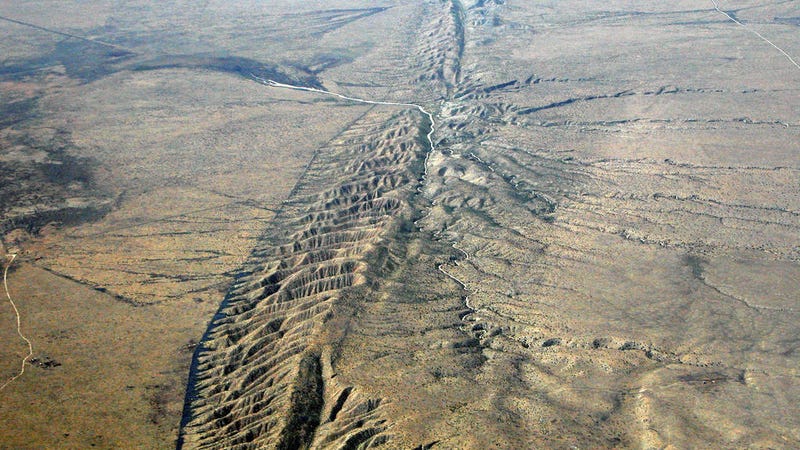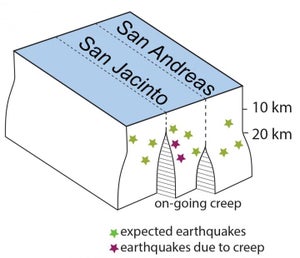
A section of the San Andreas Fault on the Carrizo Plain in California.
Image: Doc Searls/Flickr
Posted on 09/23/2018 7:53:32 AM PDT by ETL

A section of the San Andreas Fault on the Carrizo Plain in California.
Image: Doc Searls/Flickr
The detection of strange, unpredicted behavior deep below the surface near the San Andreas and San Jacinto faults suggests scientists have an incomplete understanding of the processes responsible for earthquakes in the region.
Over the past four decades, geoscientists have recorded thousands of small earthquakes in California’s San Bernardino basin near the San Andreas and San Jacinto faults. New research published in Geophysical Research Letters suggests many of these quakes, some of which occur at depths between 6 and 12 miles (10 and 20 kilometers), are exhibiting surprising deformation patterns. Instead of slipping in a horizontal manner, many of these earthquakes show vertical movement far below the surface.
This previously undetected movement, dubbed “deep creep,” suggests things aren’t happening beneath the San Andreas and San Jacinto faults in the ways we think they are. And that’s a problem, given the history of the region. Regions along these major faults are vulnerable to damaging earthquakes, the most recent being the 1989 Loma Prieta quake (in the Santa Cruz Mountains south of the Bay area), which registered a magnitude 6.9, killed over 60 people, and caused upward of $6 billion in damages.

Illustration depicting anomalous earthquakes—the deep creep—
near the San Andreas and San Jacinto faults in southern California.
Image: UMass Amherst/Michele Cooke
Surprisingly, one-third of all small earthquakes detected in the region since 1982 are of the deep creep variety, according to the authors of the new study, geoscientists Michele Cooke and Jennifer Beyer from the University of Massachusetts Amherst. These enigmatic slips are mostly occurring to the northeast of the San Jacinto Fault, and primarily below depths of 6 miles. This strange behavior, the authors say, was completely missed by scientists, the impacts of which now need to be determined.
“These little earthquakes are a really rich data set to work with, and going forward if we pay more attention than we have in the past to the details they are telling us, we can learn more about active fault behavior that will help us better understand the loading [the buildup of seismic pressure] that leads up to large damaging earthquakes,” said Cooke in a statement.
The deep creep earthquakes analyzed by Cooke and Beyer occur beside and between the two primary faults, and they produce distinctive deformations compared the ones produced by the large, ground-rupturing variety. The San Andreas and San Jacinto faults are strike-slip faults, and their movement can be compared to two blocks sliding horizontally past one another. The motion of the deep creep slips are noticeably different, with one block pulling away from the other at an angle—a wave-like movement that extends the fault. These anomalous slip-sense faults, as they’re called, only seem to occur in one small area, and the researchers were at a loss to explain why.
Normally, geoscientists use GPS to detect and measure seismic slips, where the location between GPS stations on each side of the fault shift in the wake of an earthquake. In this case, however, GPS could not be used because the smaller faults are too close together.
So, to figure out what was going on deep below, Cooke did what any good scientist would: She built a 3D model. Or more specifically, a computer simulation that does 3D fault modeling.
“That gave me a clue that maybe those [smaller] faults weren’t locked as they should be between big earthquakes, but that at depths below 10 kilometers, they were creeping,” said Cooke. “In this paper we’ve shown that there is a way to have these weird tiny earthquakes all the time next to the San Jacinto Fault below 10 km, which is where deep creep may be happening. We show that it’s plausible and can account for nearby enigmatic earthquakes. The model may not be perfectly correct, but it’s consistent with observations.”
As noted by Cooke, geoscientists has previously assumed that the smaller faults in this region were locked in place. So with no apparent creep going on below, scientists calculated the amount of load being placed onto the two primary faults by using data produced by the thousands of smaller quakes. This could carry potentially serious implications, as geoscientists now need to rethink the way energy is accumulating below the surface. As the authors write in study:
"The findings of this study demonstrate that small earthquakes that occur adjacent to and between faults can have very different style of deformation than the large ground rupturing earthquakes produced along active faults. This means that scientists should not use the information recorded by these small earthquakes in the San Bernardino basin to predict loading of the nearby San Andreas and San Jacinto faults."
Speaking to Newsweek, John Vidale, director of the the Southern California Earthquake Center, said the study was “quite well founded,” and certain specialists may be “sad to see the interpretability of their models undercut.” However, Vidale said the study’s implications were “profoundly ambiguous,” and that Cooke and Beyer failed to flag anything particularly dangerous that experts haven’t identified before.
That said, it’s kinda scary for these researchers to find a previously undocumented process happening in this area. Ultimately, however, this is good news. Armed with this knowledge, scientists can now study these deep creeps further to improve our understanding of this seismically tumultuous region of California.
Correction: An earlier version of this article misstated the location of the 1989 Loma Prieta quake.
[Geophysical Research Letters]
Absolutely. When it comes to GoreBull Warming, all of the ordinary rules get flushed down the toilet.
<<< Wouldn’t it be nice if CLIMATE scientists took the same approach to their research efforts?
1 - theory
2 - observe nature
3 - evaluate results
4 - revise theory for better fit
5 - go back to (2) >>>
Instead the climate liars, observing that nature was not echoing their computer-modeled results, revised the observations to fit the theory.
They should ask Bill Nye. He knows everything!
Funny thing about science and scientists...
The more they learn, the less they know.
I thought it was global warming... but I guess that’s Trump’s fault, too.

This IS the world, remember? WTF can ya ‘spect?
Nothing @ best!
++++++++++++++
GunnyG@PlanetWTF???
TRUMP.45IF???WeCanKeepHim?
+++++++++++++++++++++++++++++
Lol! Biggest fake scientist there is.

In a NASA town hall yesterday (May 17), NASA's new administrator, Jim Bridenstine, said that he knows Earth's climate is changing, and that humans contribute to it "in a major way," also supporting NASA's research into that important area. The statement is significant because Bridenstine has expressed doubt about human-caused climate change in the past, causing some to question his suitability to lead a fact-focused NASA.
In 2013, as an Oklahoma congressman, Bridenstine claimed there was no current trend toward global warming. More recently, such as in his NASA administrator confirmation hearings last November, he has acknowledged that human activity contributes to climate change. But he had stopped short of saying that humans are the phenomenon's primary cause.
At the NASA employee town hall, Bridenstine described how his thinking had "evolved" on the topic and laid out his current beliefs.
"I don't deny the consensus that the climate is changing; in fact, I fully believe and know that the climate is changing," he said. "I also know that we, human beings, are contributing to it in a major way. Carbon dioxide is a greenhouse gas. We're putting it into the atmosphere in volumes that we haven't seen, and that greenhouse gas is warming the planet.
"That is absolutely happening, and we are responsible for it," he added. "NASA is the one agency on the face of the planet that has the most credibility to do the science necessary so that we can understand it better than ever before."
(Excerpt) Read more at foxnews.com ...
Let ‘Er Rip.
Well, that is the nature of reality. It seems to be infinitely complex. We will probably never get to the ultimate 'truth', if there even is such a thing as 'ultimate truth'.

Very true and well said.
The first step in your process is “hypothesis,” not “theory.” The theory only comes after mountains of observation and experimentation, and forms the conceptual framework that gives meaning to the process being studied. While scientists do revise theory as they gather more data, formulating a theory is never the first step. Usually, the first step is observational, then hypothesizing, then testable experimentation, then analysis of results, then revisiting the hypothesis and revising as necessary, then experimentation again, etc.
You are correct in that climate scientists do not do this with respect to anthropogenic global warming. Unfortunately, this is a field of pathologic research which does not die because politicians of a certain ilk can use it to further their goals of complete control over the people.
No, but in a review of the piece it will be added in by the MSM. They probably have a series of prewritten paragraphs saved to add to any such article.
No doubt about that. It's how they operate.
YUP!
And you will then be known as Big Green (or blue...or yellow...or...) Badger.
They never learn.
Southern California beach bum is my dream life.
Okay,
We’re Good!
or rotting,stinking Meat Sack!
Dye vs. Die
Disclaimer: Opinions posted on Free Republic are those of the individual posters and do not necessarily represent the opinion of Free Republic or its management. All materials posted herein are protected by copyright law and the exemption for fair use of copyrighted works.